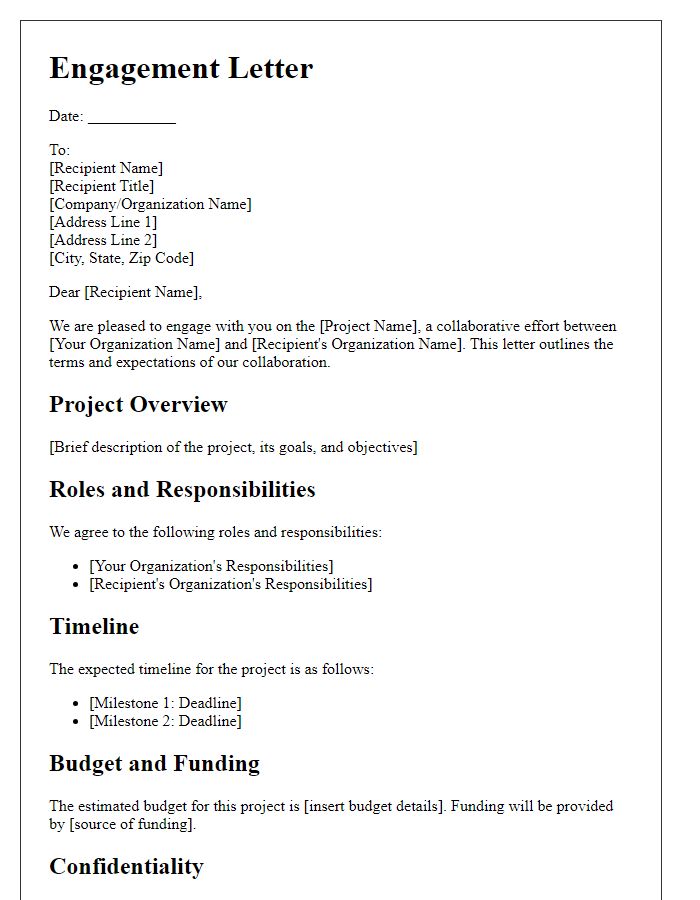Are you looking to embark on an exciting project collaboration? Crafting a well-structured agreement letter is key to ensuring both parties are on the same page and set up for success. This document not only outlines the expectations and responsibilities, but also fosters a spirit of teamwork and transparency. Dive into our comprehensive guide to discover how to create the perfect collaboration agreement that meets your project's needs!

Clear project objectives
A clear project objective serves as the foundation for successful collaboration in various initiatives, such as research studies, community development programs, or technological projects. Defining specific, measurable goals--such as increasing efficiency by 20% within six months or improving user engagement metrics from 30% to 50% over the next quarter--ensures all stakeholders, including team members, investors, and community partners, are aligned. A designated timeframe, milestones for progress assessment, and the resources allocated, such as budget estimates or human capital, must also be outlined to facilitate accountability and transparency throughout the project lifecycle. Regular updates and feedback mechanisms ensure that objectives remain relevant and allow for adjustments as necessary to meet changing circumstances or emerging opportunities.
Defined roles and responsibilities
In collaborative projects, clearly defined roles and responsibilities ensure efficient workflow and accountability among team members. Project managers (individuals overseeing project execution) typically coordinate schedules, resources, and team communications, while subject matter experts (individuals with specialized knowledge relevant to the project) provide technical insight and guidance. Team members (employees actively engaged in project tasks) are responsible for completing assigned duties, meeting deadlines, and maintaining quality standards. Stakeholders (individuals or groups with vested interest in project outcomes) offer feedback and strategic direction. Establishing these roles at the project's outset fosters transparency and collaboration, enhancing the likelihood of successful outcomes.
Intellectual property rights
A project collaboration agreement on intellectual property rights establishes the framework for sharing creative outputs among collaborative partners. This document outlines ownership of intellectual property (IP) developed during the project, detailing how each party contributes their expertise, resources, and innovations. Specific clauses define joint ownership parameters, protecting proprietary technology, designs, and trademarks unique to each contributor. The agreement should stipulate the process for licensing, commercialization, and profit sharing related to the IP created in collaboration, ensuring all parties benefit equitably. Key considerations include the jurisdiction governing the agreement, methods for dispute resolution, and confidentiality provisions protecting sensitive information disclosed during the partnership.
Confidentiality agreements
Confidentiality agreements are crucial for protecting sensitive information during project collaborations. These agreements ensure that all parties, such as companies, organizations, or individuals involved, maintain confidentiality regarding proprietary data, trade secrets, and intellectual property throughout the project duration. Key elements include definitions of confidential information, obligations of the receiving party, and the duration of the confidentiality commitment. Geographic considerations, such as compliance with local laws in jurisdictions like California or the European Union's GDPR, impact how information is managed. Violations can lead to legal repercussions, including financial penalties or restrictions on future collaborations. Properly structured confidentiality agreements foster trust, encouraging open communication and innovative problem-solving.
Termination clauses
Termination clauses outline the specific conditions under which a project collaboration agreement can be ended. These clauses often include provisions such as breach of contract, failure to meet obligations, or mutual consent. For instance, if one party fails to deliver critical deliverables by agreed deadlines, the other party may have the right to terminate the agreement after providing a notice period, typically ranging from seven to thirty days. Additionally, a clause may address termination for convenience, allowing either party to exit the agreement without cause, usually requiring a formal written notice and a specified notice period. In cases of insolvency or bankruptcy of one party, immediate termination may be invoked to protect the interests of the other party involved. Overall, clear termination clauses provide structure and security, ensuring that both parties understand their rights and responsibilities in the event of an agreement ending.
Letter Template For Project Collaboration Agreement Samples
Letter template of mutual collaboration agreement for project development

Letter template of consortium agreement for multi-party project collaboration












Comments